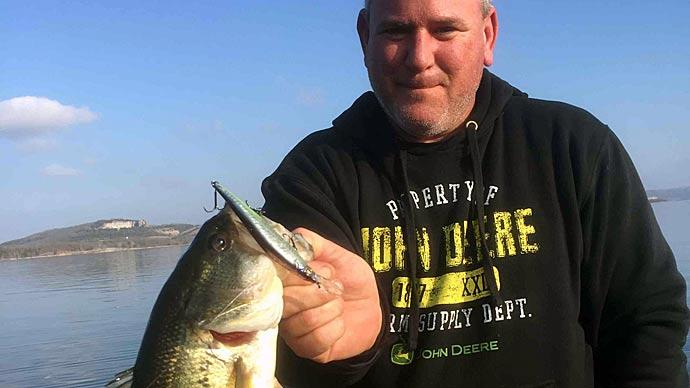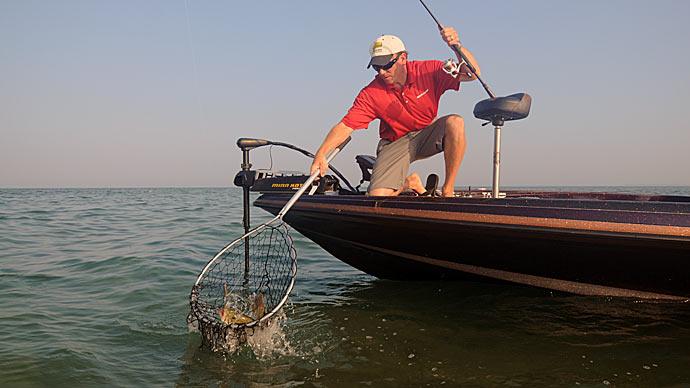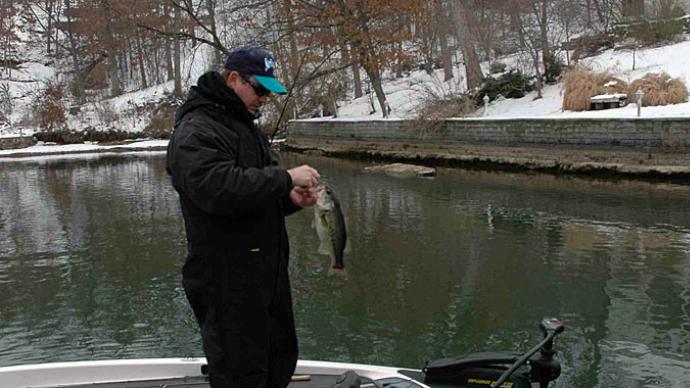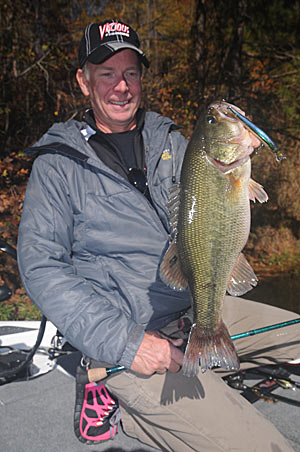
When the water temperatures drop below the 50-degree mark, Kevin Short ensures he has a suspending stickbait tied on to tempt wintertime bass.
The former Bassmaster Elite Series pro knows a suspending stickbait produces best for wintertime bass because it can be fished slow enough to match the movements of bass and their prey. “Typically, the water is pretty cold, and bass are pretty lethargic,” Short says. “It seems like the bait is moving around really slow too. You are imitating (with a suspending stickbait) what the baitfish are doing that time of the year.”
The Arkansas tournament veteran believes the suspending stickbait produces best when the water temperature ranges from the upper 40’s down to near ice level. “There are now baits that are specifically weighted to suspend in the low to mid 40s temperature range, and if it is warmer or cooler, the lures will either sink or float,” Short says. “So the manufacturers now are tuning them to a certain temperature range.”
In frigid water, Short notices the temperature-tuned suspending stickbaits tend to sink, which he favors because shad are usually dying and sinking then. When the water temperature is in the middle to upper 40s, Short prefers his suspending stickbaits to float because bass are more active. When he pauses the lure then, and it starts to float upward, Short notices the rising lure triggers a reaction bite because a bass perceives the lure is fleeing from it.
Suspending stickbaits work best for Short in water clarity of at least two to three feet of visibility. He has caught bass on the lures on both sunny and cloudy days. “The key for me is to match the colors of the bait to the conditions,” Short says. He selects a white or light chartreuse lure for cloudy days and a stickbait with transparent or chrome colors for sunny skies.
A light wind is ideal for Short’s suspending stickbait presentation. “With too much wind, it is hard to make the bait sit still because the wind is pulling on your line, and it’s moving the boat,” he says. “So the less wind is probably better.”
His favorite stickbaits are usually about 4 3/4 to 5 inches long such as the Megabass Vision 110 or the Lucky Craft Pointer 100. He will also throw the Megabass Vision 110 +1 on gin clear lakes if he notices bass are suspended deeper than the depth range of the standard Megabass 110.
Relying on his Garmin electronics with Panoptix LiveScope technology has made suspending stickbait fishing easier for Short. “It is like cheating,” he says. “You can see the fish and the bait and how the fish react to the bait. I have seen a group of fish sitting out in front of a dock, and I have thrown like a white stickbait. When I brought it through them, the fish just scattered. After I let them regroup, I threw a chrome stickbait through there, and when it got close to one of them, a bass immediately ran over and grabbed the stickbait.”
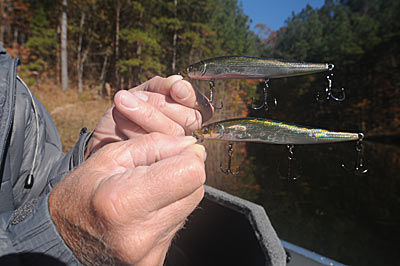
Short varies his retrieve until he figures out how the fish want the lure presented. After his lure enters the water, Short winds his reel handle about four or five turns to make the lure dive and then lets it sit for a while. Then he twitches his rod twice and pauses the lure again. He varies the length of his pauses until he gets a bite. “When you are using your electronics, and you can see where the fish are, I don’t think you can let it sit in front of a fish long enough,” Short says.
When pausing the lure, Short keeps some slack in his line and watches for line movement to detect a strike. Short prefers the lure to either remain neutrally buoyant on the pause or slightly sinking. “I don’t want them to float in the wintertime,” he says. “I would rather have the lure sink real slow than float.” If he notices his lure is rising, Short will modify the lure to make it suspend better by putting lead wire on the hook, lead tape under the bill, or the belly or bigger hooks on it.
For most situations, Short prefers his stickbait points nose down during the pause. Short has noticed a stickbait that points nose up on the pause generates strikes in frigid water when shad are dying and sinking tail first.
Short’s gear for suspending stickbait fishing consists of a 6-foot, 6-inch or 6-foot, 8-inch medium action casting rod with a 6.8:1 gear ratio baitcast reel filled with either monofilament or fluorocarbon line. He opts for fluorocarbon if he wants the lure to dive deeper or sink more but switches to monofilament if he wants the lure to float more or remain neutrally buoyant. Short mainly uses 10-pound test line but will opt for 8-pound test to make his lure dive deeper or upgrade to 12-pound test for fishing around stumps or docks.
The three-time Bassmaster Classic qualifier stresses the importance of using the right hooks for suspending stickbaits. “I have had the best success with light wire hooks because they penetrate so much easier,” he says. The Mustad Triple Grip TG58 is Short’s favorite hook for his suspending stickbaits.
Short emphasizes finding “bunched-up bait” as the key to his winter stickbait fishing. He usually finds the balls of baitfish and bass in the deepest part of a channel bend. Bluff ends, points, and edges of flats are also good locations to throw suspending stickbaits, especially if these structures feature cover such as stumps, standing timber, or boat docks.
The tactic tricks bass of all sizes when fishing a suspending stickbait in the winter. “One of the cool things is the fish could be 12 inches long, or it could be 6 or 7 pounds,” Short says.
BassResource may receive a portion of revenues if you make a purchase using a link above.


